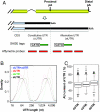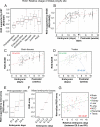Progressive lengthening of 3' untranslated regions of mRNAs by alternative polyadenylation during mouse embryonic development
- PMID: 19372383
- PMCID: PMC2669788
- DOI: 10.1073/pnas.0900028106
Progressive lengthening of 3' untranslated regions of mRNAs by alternative polyadenylation during mouse embryonic development
Abstract
The 3' untranslated regions (3' UTRs) of mRNAs contain cis-acting elements for posttranscriptional regulation of gene expression. Here, we report that mouse genes tend to express mRNAs with longer 3' UTRs as embryonic development progresses. This global regulation is controlled by alternative polyadenylation and coordinates with initiation of organogenesis and aspects of embryonic development, including morphogenesis, differentiation, and proliferation. Using myogenesis of C2C12 myoblast cells as a model, we recapitulated this process in vitro and found that 3' UTR lengthening is likely caused by weakening of mRNA polyadenylation activity. Because alternative 3' UTR sequences are typically longer and have higher AU content than constitutive ones, our results suggest that lengthening of 3' UTR can significantly augment posttranscriptional control of gene expression during embryonic development, such as microRNA-mediated regulation.
Conflict of interest statement
The authors declare no conflict of interest.
Figures



References
-
- Wickens M, Anderson P, Jackson RJ. Life and death in the cytoplasm: Messages from the 3′ end. Curr Opin Genet Dev. 1997;7(2):220–232. - PubMed
-
- Keene JD. RNA regulons: Coordination of post-transcriptional events. Nat Rev Genet. 2007;8(7):533–543. - PubMed
-
- Garneau NL, Wilusz J, Wilusz CJ. The highways and byways of mRNA decay. Nat Rev Mol Cell Biol. 2007;8(2):113–126. - PubMed
-
- Filipowicz W, Bhattacharyya SN, Sonenberg N. Mechanisms of post-transcriptional regulation by microRNAs: Are the answers in sight? Nat Rev Genet. 2008;9(2):102–114. - PubMed
Publication types
MeSH terms
Substances
Grants and funding
LinkOut - more resources
Full Text Sources
Other Literature Sources
Molecular Biology Databases

